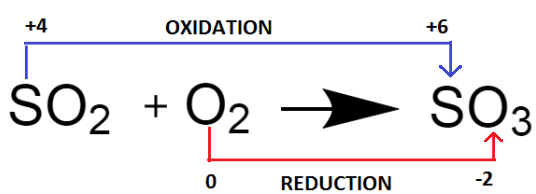
In the reaction below, State what is being oxidized and what is being reduced?
Answer
399.3k+ views
Hint: The process of oxidation that takes place is described by the loss of electrons by an atom or by a group of atoms. The process of reduction that takes place is described by the acceptance of electrons by an atom or by the group of atoms. Chemical reactions which include both of them are known as redox reactions.
Complete answer:
There are some ways to determine whether the process of oxidation occurs or not like:
Similarly, the process of reduction is also determined:
In the given chemical reaction:
Firstly, we have to calculate the oxidation number of each of the atoms present in the reaction.
Oxidation number of sulphur
On solving the above equation, we get
Oxidation number of
On solving the above equation, we get
As we see, the oxidation number of sulphur atoms increases
Oxidation number of Oxygen
Oxidation number of Oxygen
On solving, we get
On calculating, we get
As we see, the oxidation number of oxygen atoms decreases from

Note:
Substances which tend to accept one or more electrons are known as oxidizing agents like
Complete answer:
There are some ways to determine whether the process of oxidation occurs or not like:
Similarly, the process of reduction is also determined:
In the given chemical reaction:
Firstly, we have to calculate the oxidation number of each of the atoms present in the reaction.
Oxidation number of sulphur
On solving the above equation, we get
Oxidation number of
On solving the above equation, we get
As we see, the oxidation number of sulphur atoms increases
Oxidation number of Oxygen
Oxidation number of Oxygen
On solving, we get
On calculating, we get
As we see, the oxidation number of oxygen atoms decreases from

Note:
Substances which tend to accept one or more electrons are known as oxidizing agents like
Recently Updated Pages
Master Class 9 General Knowledge: Engaging Questions & Answers for Success

Master Class 9 English: Engaging Questions & Answers for Success

Master Class 9 Science: Engaging Questions & Answers for Success

Master Class 9 Social Science: Engaging Questions & Answers for Success

Master Class 9 Maths: Engaging Questions & Answers for Success

Class 9 Question and Answer - Your Ultimate Solutions Guide

Trending doubts
State and prove Bernoullis theorem class 11 physics CBSE

What are Quantum numbers Explain the quantum number class 11 chemistry CBSE

Who built the Grand Trunk Road AChandragupta Maurya class 11 social science CBSE

1 ton equals to A 100 kg B 1000 kg C 10 kg D 10000 class 11 physics CBSE

State the laws of reflection of light

One Metric ton is equal to kg A 10000 B 1000 C 100 class 11 physics CBSE




